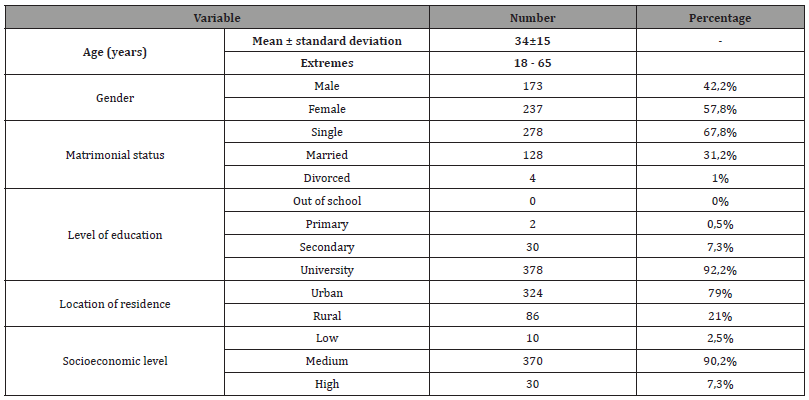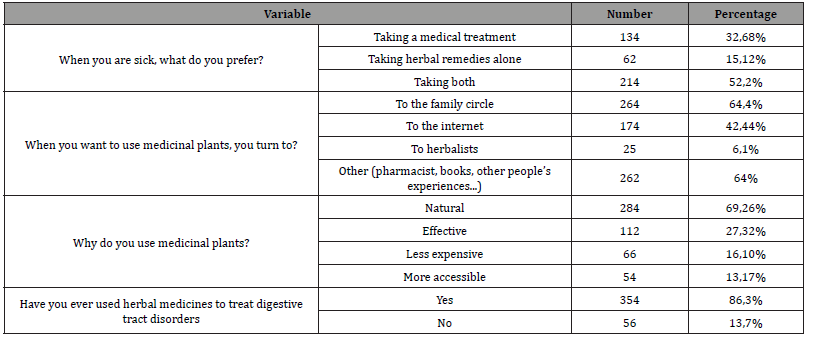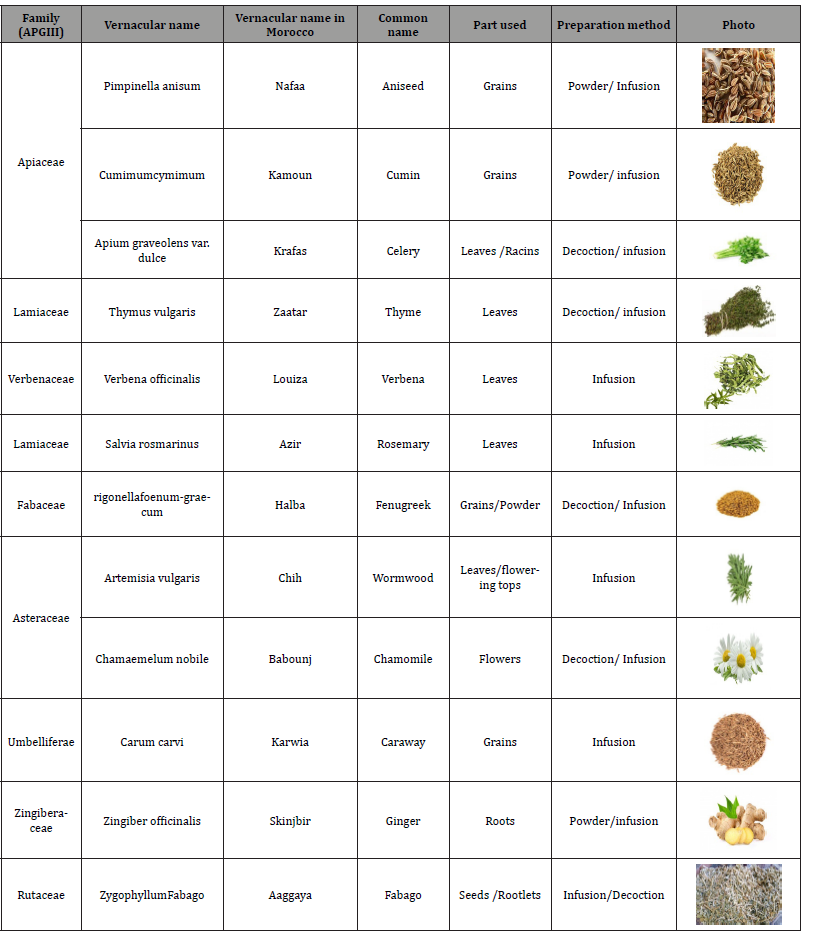 Research Article
Research Article
Medicinal Plants in the Treatment of Digestive Diseases in Morocco: Knowledge and Practices
Lemfadli Y1*, Jallouli Abderrahmane1, Ait Errami Adil1, Oubaha Sofia2, Samlani Zouhour1 and Krati Khadija1
1Hepato-gastroenterology department, University hospital of Mohammed VI, Marrakesh, Morocco
2Physiology Laboratory, Faculty of Medicine and Pharmacy, Cadi Ayyad University, Marrakesh, Morocco
Lemfadli Y, Hepato-gastroenterology department, University hospital of Mohammed VI, Marrakesh, Morocco.
Received Date:January 03, 2022; Published Date:February 02, 2022
Abstract
Introduction: The use of medicinal plants and phytotherapy is characterized by its popularization and scientific and legislative neglect. The aim
of this study is to evaluate the state of the art of the use of medicinal plants by the Moroccan population to treat digestive tract disorders.
Materials and Methods: We performed a descriptive cross-sectional study of 410 Moroccan citizens. Data were collected through an electronic
questionnaire distributed online. The participants also indicated their socio-demographic data, their knowledge and their practices towards
medicinal plants that they use to treat digestive disorders.
Results: The mean age of our participants was 34 years with a marked female predominance (57.8%). The ethnobotanical investigation
revealed that the digestive symptoms justifying the use of medicinal plants were dominated by epigastralgia (45.9%), atypical abdominal pain
(32.2%), bloating (44.9%), diarrhea (34.6%) and constipation (26.3%). The taxonomic identification of plants used has identified 32 species of
which the most represented are thymus vulgaris (72.19%), followed by cumimumcymimum (58.54%), then comes pimpinellaanisum (50.73%)
and rigonellafoenum-graecum (49.02%). The improvement of symptoms by these plants was mentioned by most of the participants (73.9%). The
majority of the respondents (60%) affirmed that there were no side effects related to these plants.
Conclusion: Our results confirm the need to pay attention to the use of medicinal plants in our context. Firstly, the efficacy and safety of these
medicinal plants must be verified through scientific research. Moreover, like medicines, the use of these plants must obey legislative rules involving
the regulation of the profession in our country.
Keyword: Medicinal plants; Digestive diseases; Morocco
Introduction
Since ancient times, plants have been used as medicines. Medicinal plants are valuable resources for the vast majority of rural populations in Africa, where more than 80% of the population uses them for health care [1,2]. In Morocco, medicinal plants occupy an important place in traditional medicine. Indeed, Morocco is one of the Mediterranean countries that has a traditional expertise in medicinal plants [3,4].
In this objective, we aim through this study carried out on a national scale to provide the current state of therapeutic uses of medicinal plants in the treatment of digestive system disorders and diseases.
Materials and Methods
Participant characteristics
We conducted a descriptive transversal study based on an online questionnaire. All participants were adults over the age of 18, resident in Morocco. To have a representative national sample, we interviewed citizens across different regions of Morocco.
Study procedure
Study announcements, containing brief information about the study and a link to a questionnaire, were shared via email (to personal and professional networks), and posted on Facebook and other popular social media websites, including Twitter and Instagram to have a diverse sample. The online questionnaire was administered via Google Forms to ensure wide reach and easy access. Participants were asked to share the questionnaire with their families and contacts.
Responses to all questionnaire items were required, and respondents could only submit their responses if all questions were answered. The data reported in this study were collected between May and September 2021.
Ethical approval
Participation was voluntary, and all participants gave informed consent electronically and without compensation for participation. No identifying information was collected to protect the anonymity of participants.
Variables studied
Participants provided their socio-demographic characteristics, such as gender, age, education level and location (rural or urban). They also reported their knowledge and use of medicinal plants to treat symptoms and diseases of the digestive tract, including the type and method of preparations used, their therapeutic benefits and possible toxicities.
Statistical analysis:
We report descriptive statistics for the study variables. Analyses were performed by IBM SPSS Statistics v 21 software.
Results
Table 1: Description of participants (n= 410).

Four hundred and ten participants completed the questionnaire. Table 1 presents the descriptive characteristics of the participants. The average age was 34 years (±15). The majority of participants were female (57.8%), single (67.8%), had a university degree (92.2%) and lived in urban areas (79%) (Table 1).
Concerning the use of medicinal plants Table 2: 15.12% prefer to take medicinal plants alone when they fall ill and 52.2% combine them with a medical treatment. 64.4% of the respondents turn to the experiences of the family circle to use medicinal plants. More than two thirds of the participants use medicinal plants because they are natural (Table 2).
Table 2:Use of medicinal plants (n= 410).

The majority of respondents (86.3%) had already used plants to treat digestive disorders. The patients in our series used a single plant (87.5%), while 12.5% used a combination of several medicinal plants. The digestive symptoms justifying the use of medicinal plants were dominated by epigastralgia (45.9%), atypical abdominal pain (32.2%), bloating (44.9%), diarrhea (34.6%) and constipation (26.3%) (Figure 1).

The participants counted several species of medicinal plants that were used. Table 3 represents the most common species belonging to nine botanical families. It includes scientific names, vernacular names, names based on the APG III system (Angiosperm phylogeny group, APG III, 2009), as well as the part used and the method of preparation (Table 3).
Table 3:

Thyme (Thymus vulgaris) was the most used species (72.19%), followed by cumin (Cumimumcymimum) (58.54%), then green anise (Pimpinella anisum) (50.73%), fenugreek (rigonellafoenum- graecum) (49.02%), verbena (Verbena officinalis) (46.82%) and rosemary (Salvia rosmarinus) (40.73%). Leaves were the most used plant part (64.8%), while decoction was the most mentioned method of preparing therapeutic recipes (59.2%) (Figure 2).

The majority of participants (70.9%) report that they use medicinal plants on demand and 14.3% use them until they are cured. Concerning the knowledge on the side effects of these plants: 60% of the participants report that there are no side effects related to these plants and 35.8% do not know if there are effects or not. Concerning the benefit of the use of plants in medication: 73.9% of the respondents report an improvement of the symptoms and 22.8% report that they lead to cure.
Discussion
The European Pharmacopoeia defines medicinal plants as plant drugs of which at least one part has medicinal properties. By extension, a « medicinal plant » or « plant » is often referred to not only as the botanical entity but also as the part used (leaf, flower, root, bark, flowering top...).” [5]. Since ancient times, plants have been used by the Moroccan population for food and medicine. Indeed, Moroccan ethnobotanical studies have shown that 365 species of plants are used as food, medicinal, aromatic, condimentary and toxic and 500 preparations used to treat different pathologies are based on plants [6].
Digestive diseases are frequent and the use of phytotherapy to remedy these disorders is also frequent in Morocco. A recent Moroccan study has shown that the main plants used in the treatment of digestive disorders are represented by : cinnamon (Cinnamomum zeylanicum), mallow (Malva sylvestris L), licorice (Glycyrrhizza glabra), savory (Saturejamontana), calendula (Calendula officinalis L), aloe (Aloe vera), flax (Linumusitatissimum L), psyllium (Plantago psyllium), castor (Ricinus communis), senna (Cassia angustifolia), bistro (Polygonum bistorta), purple loosestrife (Lythrumsalicaria), anise (Pimpinella anisum), tarragon (Artemisia dracunculus) and lemon balm (Melissa officinalis) [7].
A study in the region of Fes-Meknes in Morocco showed that the most frequently used plants for acute digestive system problems were: Foeniculum vulgare, Carum carvi, Glycyrrhiza glabra, Ammondaucusleucotrichus, Trigonella foenum-graecum and Coriandrum sativum. According to this study, the symptoms justifying the use of the plants were acute abdominal pain, intestinal discomfort, bloating, diarrhea and constipation [8]. This is consistent with the results of our study. The use of leaves in the majority of preparations could be attributed to their availability, the simplicity of their harvest and their richness in therapeutic substances [9].
Study limitations
The study has some limitations. First, this study relied on a cross-sectional observational investigation. The data do not allow conclusions to be drawn about the nature or direction of the associations examined. We also do not know whether this lower quality of life existed before COVID-19. Similarly, the online self-report questionnaires may be influenced by difficulties in completing them, which could affect the validity of the data provided. Given our recruitment methods and sample size, the results may not be generalizable to the entire Moroccan population and other countries. Nevertheless, the hypotheses reported could be targets for future studies.
Conclusion
Medicinal plants are often considered by the public as safe remedies, and less harmful than synthetic drugs, since they are natural. However, this is not always the case, because they can be toxic and cause tissue damage that can be life-threatening.
Acknowledgement
None.
Conflict of Interest
None.
References
- Jiofack T, Ayissi I, Fokunang C, Guedje N, Kemeuze V (2009) Ethnobotany and phytomedicine of the upper NyongValley forest in Cameroon. African Journal of Pharmacy and pharmacology 3(4): 144-150.
- Jiofack T, Fokunang C, Guedje N, Kemeuze V, Fongnzossie E, et al. (2010) Ethnobotanical uses of medicinals plants of two ethnoecological regions of Cameroon. International Journal of Medicine and Medical Sciences 2(3): 60-79.
- Bellakhdar J (1997) The traditional Moroccan pharmacopoeia. Ancient Arab medicine and popular knowledge. Saint-Etienne, Edit. Ibis Press, pp. 764.
- Scherrer AM, Motti R, Weckerle CS (2005) Traditional plant use in the areas of Monte Vesole and Ascea, Cilento National Park (Campania, Southern Italy). J Ethnopharmacol 97(1): 129-143.
- Ollier C (2011) The Council in Phytotherapy, (2nd edn).
- De Smet PA (1993) An introduction to herbal pharmacoepidemiology. J Ethnopharmacol 38(2): 197-208.
- Meftouh F, Nejjari R (2019) Clinical herbal medicine in digestive disorders. Thesis, University Mohamed V Rabat.
- Es-Safi I, Mechchate H, Amaghnouje A, Jawhari FZ, Bari A, et al. (2020) Medicinal plants used to treat acute digestive system problems in the region of Fez-Meknes in Morocco: An ethnopharmacological survey. Ethnobotany Research and Applications 20: 1-14.
- Tra Bi F, Irie G, N’Gaman K, Mahou C (2008) Studies of some therapeutic plants used in the treatment of arterial hypertension and diabetes: Two emerging diseases in Côte d'Ivoire. Science of Nature 5: 39-48.
-
Lemfadli Y, Jallouli Abderrahmane, Ait Errami Adil, Oubaha Sofia etc all. Medicinal Plants in the Treatment of Digestive Diseases in Morocco: Knowledge and Practices. 3(4): 2022. GJNFS.MS.ID.000570.
-
Medicinal plants, Digestive diseases, Morocco, Valuable resources, Traditional medicine, Descriptive transversal, National sample, Socio-demographic characteristics, Possible toxicities, Pimpinella anisum, Thymus vulgaris
-

This work is licensed under a Creative Commons Attribution-NonCommercial 4.0 International License.






